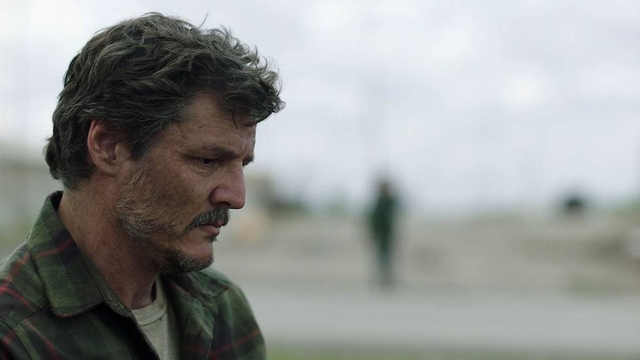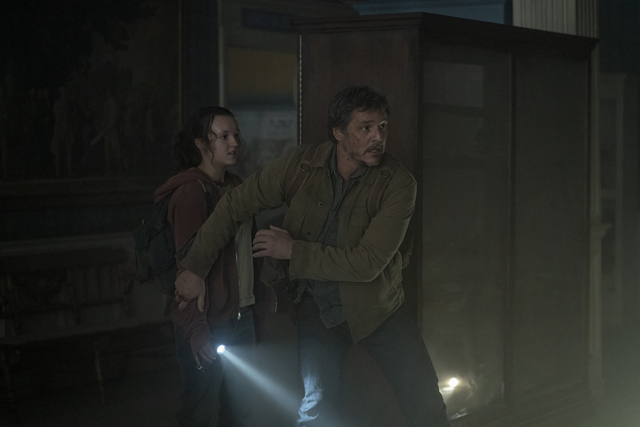In a vignette that opens the second episode of HBO’s post-apocalyptic epic The Last of Us, a professor of mycology is eating lunch in a Jakarta restaurant when two military types whisk her away mid-bite. Transported to a government lab, she inspects the corpse of a factory worker whose body is now host to a writhing, bloodthirsty fungus. When she learns that the source of the human bite that caused the dead woman’s infection remains unknown, the scientist starts to shake; the teacup in her hand rattles against its saucer. One officer begs her to help them make a medicine or a vaccine. But she knows that a cure would be impossible. Saving humanity, says the genteel academic, will require mass murder: “Bomb this city and everyone in it.”
It’s one of many chilling moments in a series, premiering Jan. 15, whose predominant moods are tense, mournful, and unnerving. And while almost all of the action in The Last of Us takes place halfway around the world from Indonesia, in the United States, the professor’s lethal prescription sets the tone for a story whose characters are constantly forced to choose between protecting themselves and their loved ones, and making existential sacrifices for the good of a plague-ravaged society. Based on the acclaimed video game franchise and created by the game’s mastermind, Neil Druckmann, and Chernobyl creator Craig Mazin, the show is by turns gorgeous and harrowing, brutal and warm. From the performances to the storytelling to the aesthetic elements, it’s an exquisitely made adaptation. But it also asks viewers to absorb a whole lot of human misery without saying much that we haven’t already heard in similar shows.
The plot is a pastiche of familiar post-apocalyptic survival narratives, though not one that too closely resembles any particular predecessor. In the show’s alternate-reality 2003, climate change catalyzes a mutation in the terrifying Cordyceps fungus that allows it to take over the human body, essentially transforming its victims into deadly zombies. Within a week of its discovery in Indonesia, the brain-colonizing affliction spreads around the globe, causing chaos, violence, the collapse of society, and the demise of the vast majority of the human race. You know the drill: one minute the frequency of ambulance sirens is a cause for mild concern; the next, people are fighting mushroom monsters who used to be their next-door neighbors.

Although we meet one of two protagonists, a contractor and single father named Joel (Pedro Pascal), just before the plague decimates his home state of Texas, most of the show takes place two decades later. Joel has made his way to Boston, where he and his partner Tess (Anna Torv) work as smugglers—a dangerous job in a ruined, walled-off city controlled by a fascist government, FEDRA, that condemns even the pettiest of criminals to public execution. Apolitical survivors by nature, the couple is gearing up for a risky trek to Wyoming, in search of Joel’s idealistic brother, Tommy (Gabriel Luna), when they become entangled in the machinations of a righteous, militant rebel faction, the Fireflies. The group’s leader, Marlene (Merle Dandridge), cuts a deal with them to escort a young woman who could hold the key to humanity’s future.
Fourteen-year-old Ellie (Game of Thrones breakout Bella Ramsey) is a headstrong, independent orphan with a remarkable secret: she is, as far as anyone can tell, the only person who’s been bitten by a zombie without being infected. If she can make it to a laboratory out west, where Firefly scientists are conducting crucial research, she might be able to help develop the cure that seemed impossible 20 years earlier. But the journey won’t be easy; networks of corpse-powered fungi still lie in wait for fresh blood, and the humans who’ve lived through the past few decades are a pretty cutthroat bunch. Further complicating things is Ellie’s delicate relationship with Joel, who’s grown hardened and gruff since losing a daughter her age in 2003.
As they travel west together, following a trajectory that supposedly hews quite closely to that of the game, Druckmann and Mazin carve out space to tell the stories of the people our heroes encounter. There’s an idyllic gated commune and a Christian cult on the verge of starvation. The closer these digressions get to individual characters, the less generic they feel. In Kansas City, a grieving community leader (Melanie Lynskey) launches a scorched-earth quest to destroy a man (Lamar Johnson) who betrayed her in an effort to save his own leukemia-stricken kid brother (Keivonn Woodard). A bittersweet vignette that comprises most of the season’s best episode casts Nick Offerman as a misanthropic survivalist who builds a relatively luxurious fortress around himself and then accidentally booby-traps the perfect person (Murray Bartlett) to share it with him.

Smartly cast and evocatively written, these side stories effectively evoke an emotional response. (Criers, be warned.) Even the surrogate parent-child bond that inevitably develops between Joel and Ellie transcends cliché thanks to the performances. Liberated from his Mandalorian mask, Pascal tempers Joel’s stoicism with glimpses of tenderness; you can see his protective-dad muscle memory kicking in despite his insistence that he sees Ellie as mere cargo. Alternately plucky, goofy, heartbreakingly naive and, necessarily, mature beyond her years, Ramsey’s sensitive portrayal of her orphaned character might be the show’s greatest asset.
Equally impressive is the visual world Druckmann and Mazin import from the game. Created in consultation with concept artists at the Last of Us’ developer, Naughty Dog—and financed with a massive budget that reportedly topped $100 million for the eight-episode debut season—the series’ backdrops vary widely but share a distinctive patina of post-apocalyptic decay. Each infected body has its own freakish, human-mushroom hybrid features, and the patterns that the fungus makes as it creeps across walls and floors and furniture are at once beguiling and nauseating. Now that so much of what we see on the big and small screens has a vaguely unreal aspect imparted by the overuse of computerized effects, it’s a particular pleasure to see a video-game adaptation that’s genuinely cinematic, immersing us in the majesty of snow-covered mountains at one moment and the grimy details of an abandoned shopping mall the next.
The Last of Us is so skillfully, meticulously, and lovingly constructed—to call it TV’s best video-game adaptation would be to damn it with faint praise—that it was tempting to ignore the question that nagged at me throughout each episode: What’s the point? It’s not that the characters’ motivations are muddled, or that the central dilemma of self vs. society isn’t explored in enough depth. But that moral conflict, which resonated with so many fans of the game, isn’t exactly novel in this medium. There have been so many post-apocalyptic dramas in recent years: The Walking Dead franchise, Sweet Tooth, The Rain, Snowpiercer, The 100, Y: The Last Man. Just about all of them touch on similar themes. The very best examples, like HBO’s own The Leftovers and HBO Max’s Station Eleven, don’t just ask whether the ends of one person’s survival justify the means; they conjure unique visions of spirituality, art, and love influenced by the ordeal of living through the end of the world. Each can be wrenching at times, but both leave viewers with profound ideas about what it means to be a person in precarious times.
I don’t know that The Last of Us has comparable insight to offer. Having never played the game, I can only imagine that the meaning-shaped hole in its otherwise robust story is something players fill with their own simulated but still, in a sense, firsthand experiences of embodying Joel and Ellie. A game that interrogates your ethics is a game that teaches you about yourself. In the form of beautifully rendered, often devastating TV, the effect is less illuminating and more masochistic. What’s the point of putting yourself through so much vicarious suffering, at a time when everyday life offers plenty of the real thing, if you’re not going to come out the other side any wiser?
Correction, Jan. 11
The original version of this story misstated the relationship between characters played by Lamar Johnson and Keivonn Woodard. Woodard plays Johnson’s younger brother, not his son.
More Must-Reads from TIME
- Donald Trump Is TIME's 2024 Person of the Year
- Why We Chose Trump as Person of the Year
- Is Intermittent Fasting Good or Bad for You?
- The 100 Must-Read Books of 2024
- The 20 Best Christmas TV Episodes
- Column: If Optimism Feels Ridiculous Now, Try Hope
- The Future of Climate Action Is Trade Policy
- Merle Bombardieri Is Helping People Make the Baby Decision
Contact us at letters@time.com